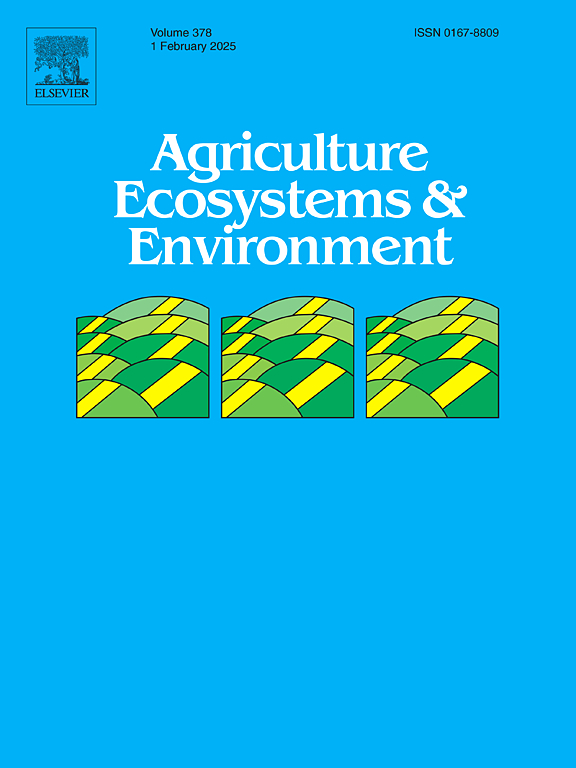Full nitrogen balances for different cattle slurry fertilization techniques in a temperate grassland
IF 6
1区 农林科学
Q1 AGRICULTURE, MULTIDISCIPLINARY
引用次数: 0
Abstract
Modern slurry application techniques have been shown to reduce ammonia losses, yet a comprehensive evaluation of their nitrogen (N)-related agronomic and ecological impacts is missing. Therefore, we utilized 15N-labeled cattle slurry to examine traditional and modern application techniques regarding their effects on hydrological and gaseous N losses, plant N uptake, soil organic nitrogen (SON) formation, and total fertilizer N balances. Following the broadcast spreading of slurry, 43 % of fertilizer N was lost as gaseous emissions, irrespective of precipitation. In contrast to broadcast spreading, significant total N emission savings were achieved by the broadcast application of diluted slurry combined with a reduced N supply (47 % emission reduction). Open slot injection at depths of 5 cm and 2 cm led to even greater emission reductions of 60 % and 74 %, respectively. Recent fertilizer was typically leached in minimal amounts only, yet the application of diluted slurry elevated nitrate leaching due to increased infiltration. Overall, the high productivity and plant N uptake were hardly affected by the application method, because over 90 % of the plants' N uptake relied on mineralized SON rather than recent fertilizer. This promoted soil N mining, particularly for broadcast spreading and slurry dilution, resulting in distinctly negative N balances (17 – 37 kg N ha−1 deficit per fertilization-harvest cycle). Utilizing slurry injection contributed to additional SON formation, effectively offsetting the N deficit and thereby supporting the long-term maintenance of N-related soil functions.
温带草原不同牛浆施肥技术的全氮平衡
现代泥浆施用技术已被证明可以减少氨损失,但缺乏对其氮素相关农艺和生态影响的综合评估。因此,我们利用15n标记的牛浆来研究传统和现代施用技术对水文和气态氮损失、植物氮吸收、土壤有机氮(SON)形成和肥料总氮平衡的影响。在播撒浆料后,无论降水如何,43% %的氮肥以气体排放的形式损失。与撒播相比,通过撒播施用稀释浆并减少氮素供应,可以显著减少总氮排放(减排47% %)。在深度为5 cm和2 cm的开槽注入,排放量分别减少了60% %和74% %。最近施用的肥料通常只有少量的浸出,但由于渗透增加,施用稀释的浆料会提高硝酸盐的浸出。总体而言,施用方式对高产和植株氮素吸收影响不大,因为90% %以上的植株氮素吸收依赖于矿化SON而不是近期肥料。这促进了土壤氮的开采,特别是在撒播和泥浆稀释中,导致明显的负氮平衡(每个施肥-收获周期N ha - 1亏缺17 - 37 kg )。利用泥浆注入有助于额外的SON形成,有效地抵消了N亏缺,从而支持与N有关的土壤功能的长期维持。
本文章由计算机程序翻译,如有差异,请以英文原文为准。
求助全文
约1分钟内获得全文
求助全文
来源期刊

Agriculture, Ecosystems & Environment
环境科学-环境科学
CiteScore
11.70
自引率
9.10%
发文量
392
审稿时长
26 days
期刊介绍:
Agriculture, Ecosystems and Environment publishes scientific articles dealing with the interface between agroecosystems and the natural environment, specifically how agriculture influences the environment and how changes in that environment impact agroecosystems. Preference is given to papers from experimental and observational research at the field, system or landscape level, from studies that enhance our understanding of processes using data-based biophysical modelling, and papers that bridge scientific disciplines and integrate knowledge. All papers should be placed in an international or wide comparative context.
 求助内容:
求助内容: 应助结果提醒方式:
应助结果提醒方式:


